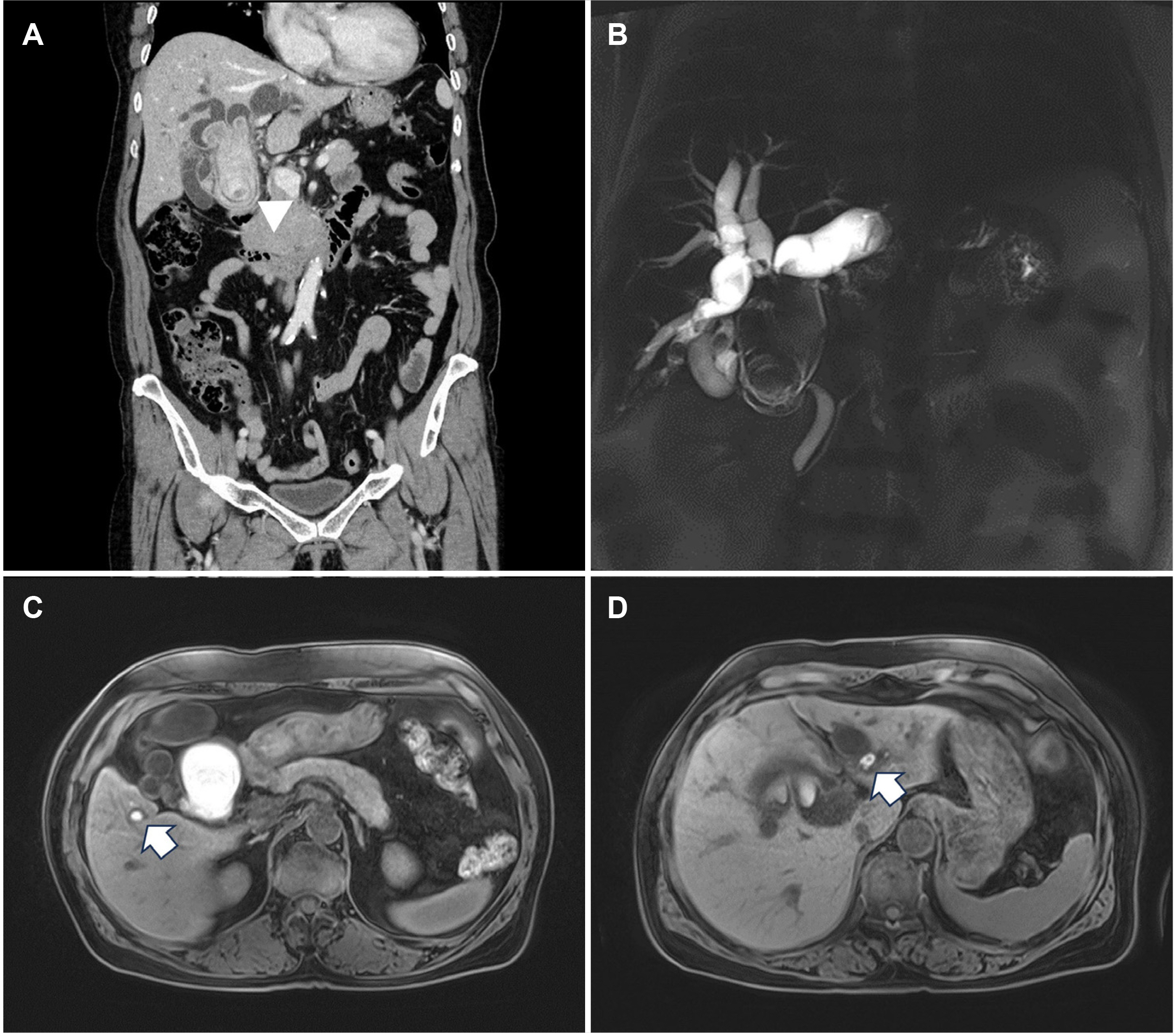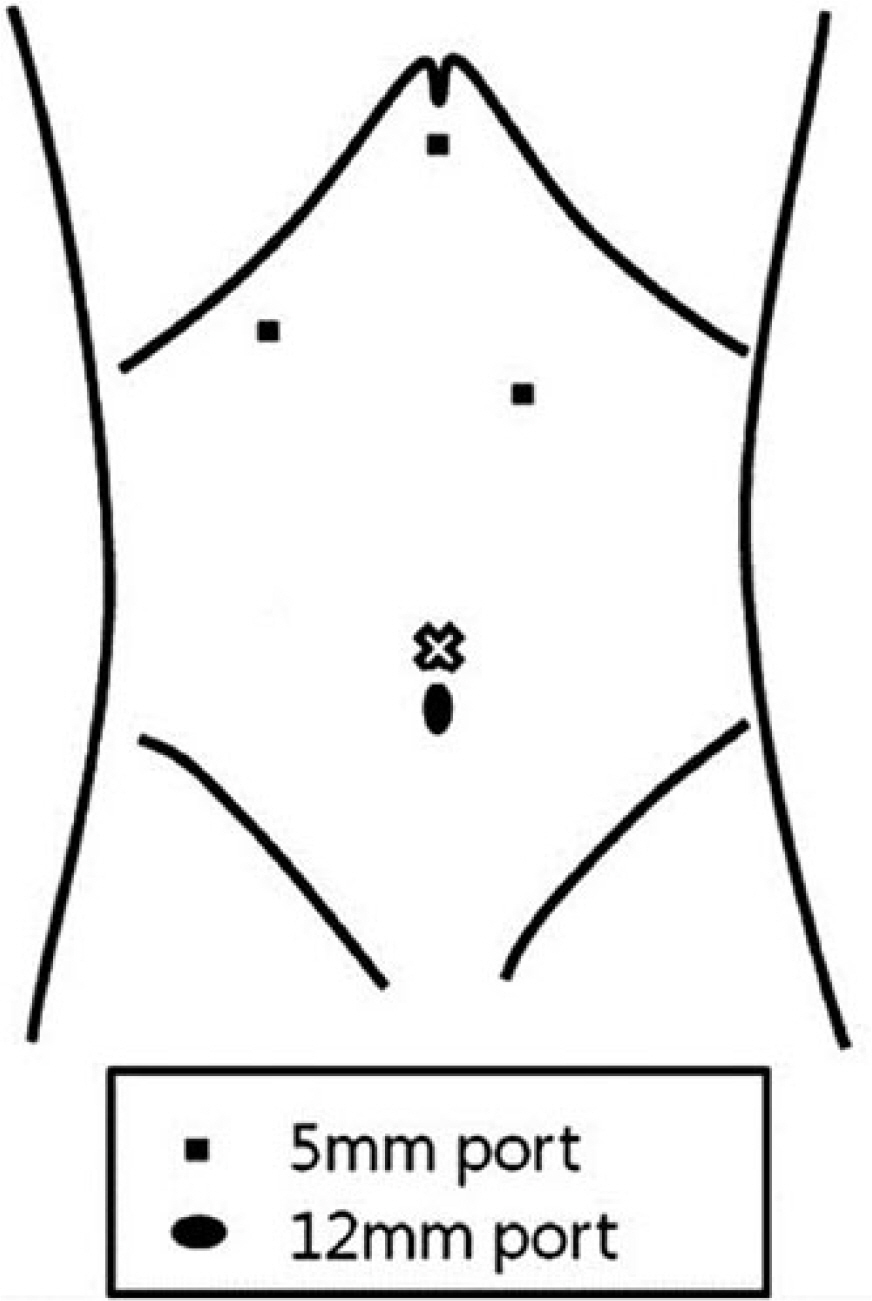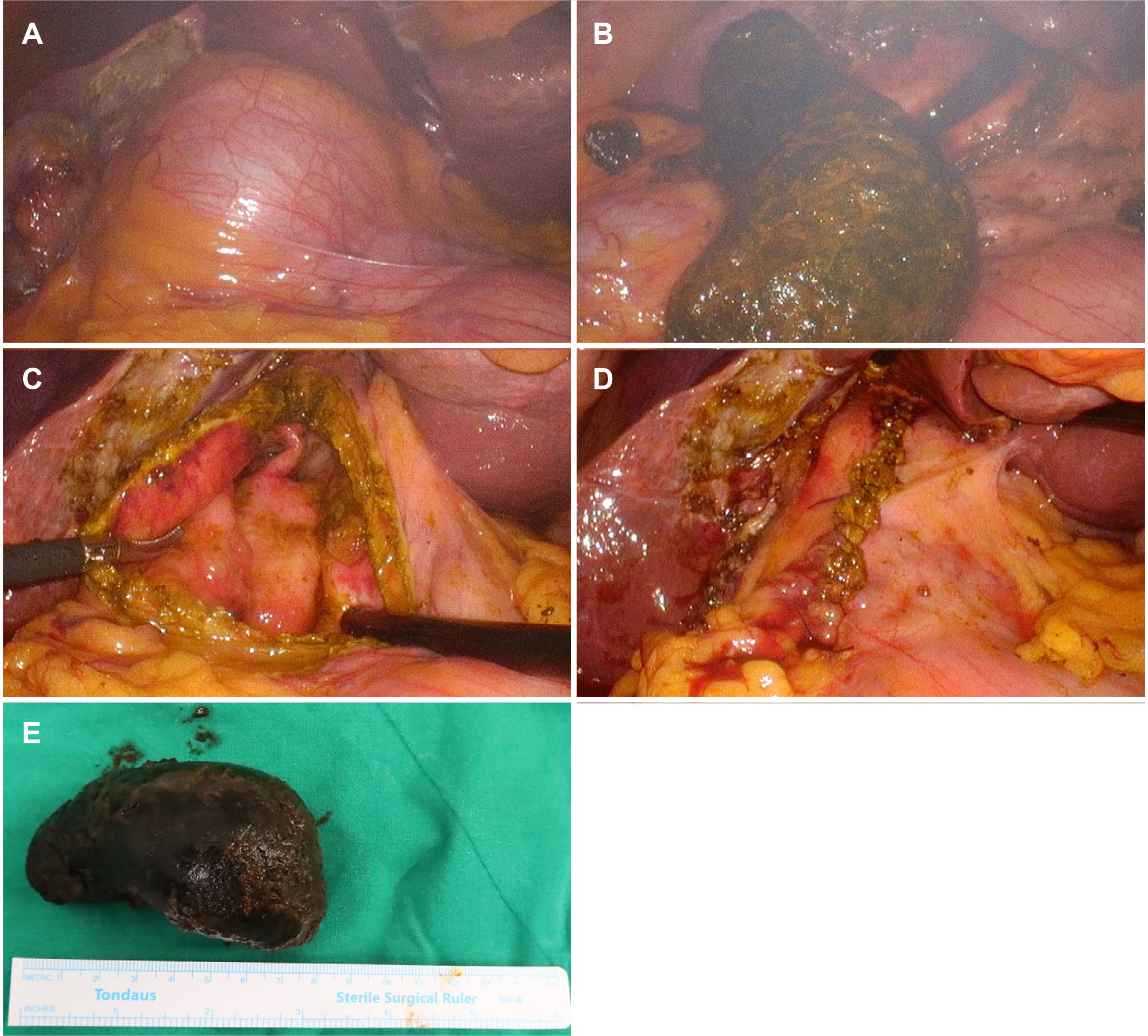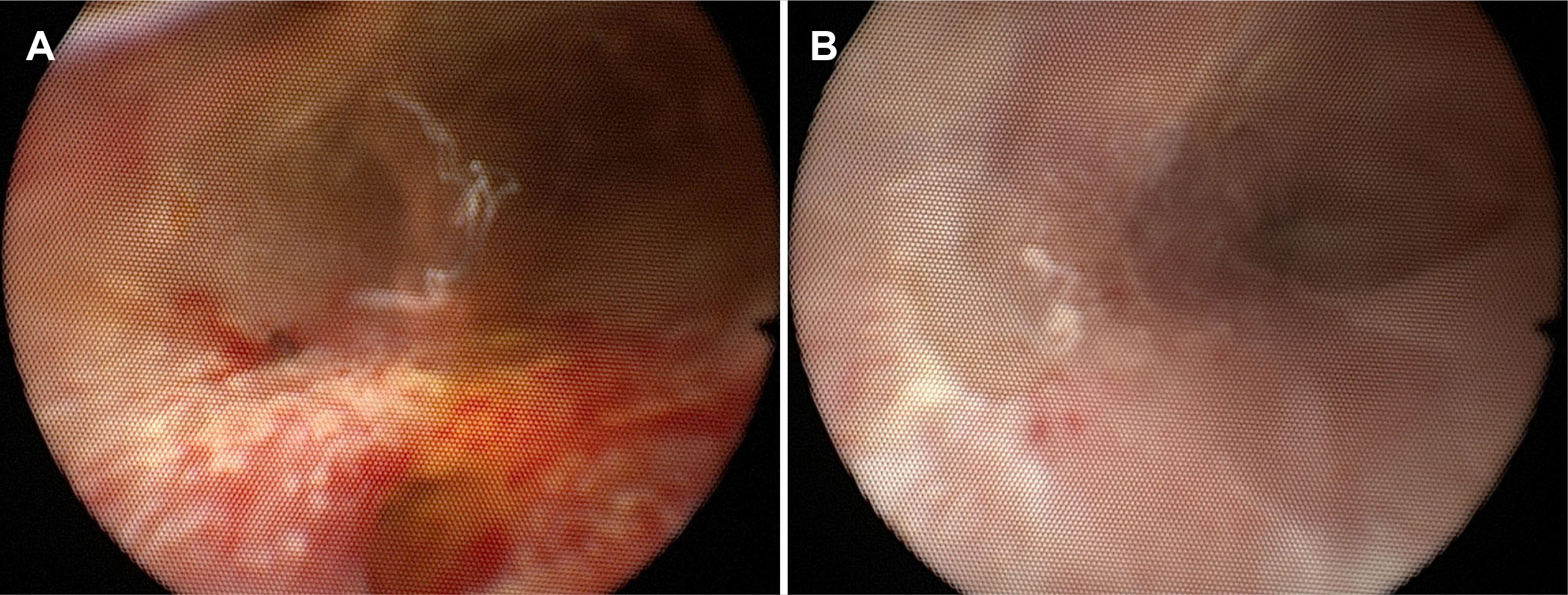Korean J Gastroenterol.
2024 May;83(5):200-204. 10.4166/kjg.2023.148.
Surgical Removal of a Huge Common Bile Duct Stone
- Affiliations
-
- 1Division of Hepato-Biliary and Pancreas Surgery, Department of General Surgery, Asan Medical Center, University of Ulsan College of Medicine, Ulsan, Korea
- 2Departments of Internal Medicine, Ulsan University Hospital, University of Ulsan College of Medicine, Ulsan, Korea
- 3Departments of Surgery, Ulsan University Hospital, University of Ulsan College of Medicine, Ulsan, Korea
- KMID: 2555973
- DOI: http://doi.org/10.4166/kjg.2023.148
Abstract
- A 65-year-old woman was diagnosed with an 8 cm large common bile duct stone and multiple stones in both intrahepatic ducts because of abnormal liver function tests. After a multidisciplinary approach, surgical removal was considered, and primary closure after laparoscopic removal of the common bile duct stone was performed. The patient recovered without complications and was discharged on the fourth postoperative day. Endoscopic removal of common bile duct stones is the standard treatment, but surgical removal through laparoscopic common bile duct exploration is also a safe and effective treatment method for such huge gallstones.
Keyword
Figure
Reference
-
1. Seitz U, Bapaye A, Bohnacker S, Navarrete C, Maydeo A, Soehendra N. 1998; Advances in therapeutic endoscopic treatment of common bile duct stones. World J Surg. 22:1133–1144. DOI: 10.1007/s002689900532. PMID: 9828721.2. Podboy A, Gaddam S, Park K, Gupta K, Liu Q, Lo SK. 2022; Management of difficult choledocholithiasis. Dig Dis Sci. 67:1613–1623. DOI: 10.1007/s10620-022-07424-9. PMID: 35348969.3. Jang SI, Lee DK. 2018; Clinical practice guideline for common bile duct stones: Diagnosis and treatment. Korean J Gastroenterol. 72:6–9. DOI: 10.4166/kjg.2018.72.1.6.4. Hintze RE, Adler A, Veltzke W. 1996; Outcome of mechanical lithotripsy of bile duct stones in an unselected series of 704 patients. Hepatogastroenterology. 43:473–476.5. Leung JW, Neuhaus H, Chopita N. 2001; Mechanical lithotripsy in the common bile duct. Endoscopy. 33:800–804.6. Lee SH, Park JK, Yoon WJ, et al. 2007; How to predict the outcome of endoscopic mechanical lithotripsy in patients with difficult bile duct stones? Scand J Gastroenterol. 42:1006–1010. DOI: 10.1080/00365520701204253. PMID: 17613932.7. Fanning NF, Horgan PG, Keane FB. 1997; Evolving management of common bile duct stones in the laparoscopic era. J R Coll Surg Edinb. 42:389–394.8. Gupta N. 2016; Role of laparoscopic common bile duct exploration in the management of choledocholithiasis. World J Gastrointest Surg. 8:376–381. DOI: 10.4240/wjgs.v8.i5.376. PMID: 27231516. PMCID: PMC4872066.9. Hanif F, Ahmed Z, Samie MA, Nassar AH. 2010; Laparoscopic transcystic bile duct exploration: the treatment of first choice for common bile duct stones. Surg Endosc. 24:1552–1556. DOI: 10.1007/s00464-009-0809-4. PMID: 20044767.10. Paganini AM, Guerrieri M, Sarnari J, et al. 2007; Thirteen years' experience with laparoscopic transcystic common bile duct exploration for stones. Effectiveness and long-term results. Surg Endosc. 21:34–40. DOI: 10.1007/s00464-005-0286-3. PMID: 17111284.11. Fang L, Wang J, Dai WC, et al. 2018; Laparoscopic transcystic common bile duct exploration: surgical indications and procedure strategies. Surg Endosc. 32:4742–4748. DOI: 10.1007/s00464-018-6195-z. PMID: 30298446.12. Salama AF, Abd Ellatif ME, Abd Elaziz H, et al. 2017; Preliminary experience with laparoscopic common bile duct exploration. BMC Surg. 17:32. DOI: 10.1186/s12893-017-0225-y. PMID: 28359270. PMCID: PMC5374560.13. Hess GF, Sedlaczek P, Zeindler J, et al. 2023; The short- and long-term outcome after the surgical management of common bile duct stones in a tertiary referral hospital. Langenbecks Arch Surg. 408:288. DOI: 10.1007/s00423-023-03011-2. PMID: 37515739. PMCID: PMC10386922.14. Kummerow KL, Shelton J, Phillips S, et al. 2012; Predicting complicated choledocholithiasis. J Surg Res. 177:70–74. DOI: 10.1016/j.jss.2012.04.034. PMID: 22682715.15. Keizman D, Shalom MI, Konikoff FM. 2006; An angulated common bile duct predisposes to recurrent symptomatic bile duct stones after endoscopic stone extraction. Surg Endosc. 20:1594–1599. DOI: 10.1007/s00464-005-0656-x. PMID: 16858527.16. Costamagna G, Tringali A, Shah SK, Mutignani M, Zuccalà G, Perri V. 2002; Long-term follow-up of patients after endoscopic sphincterotomy for choledocholithiasis, and risk factors for recurrence. Endoscopy. 34:273–279. DOI: 10.1055/s-2002-23632. PMID: 11932781.17. Park CY, Choi SH, Kwon CI, et al. 2020; What is the better surgical treatment option for recurrent common bile duct stones? Ann Surg Treat Res. 99:329–336. DOI: 10.4174/astr.2020.99.6.329. PMID: 33304860. PMCID: PMC7704274.18. Uchiyama K, Onishi H, Tani M, et al. 2003; Long-term prognosis after treatment of patients with choledocholithiasis. Ann Surg. 238:97–102. DOI: 10.1097/01.sla.0000077923.38307.84. PMID: 12832971. PMCID: PMC1422666.
- Full Text Links
- Actions
-
Cited
- CITED
-
- Close
- Share
- Similar articles
-
- Percutaneous transhepatic removal of common bile duct stone: a case report
- Laparoscopic Surgery for Common Bile Duct Stone
- Endoscopic Biliary Lithotripsy in a Patient with Gallstones of Gallbladder, Cystic Duct, and Common Bile Duct
- Non-Operative Management in Residual and Recurrent Bile Duct Stones
- A Case of Anomalous Termination of the Common Bile Duct and the Pancreatic Duct into the Duodenal Bulb, Associated with Common Bile Duct Stones





